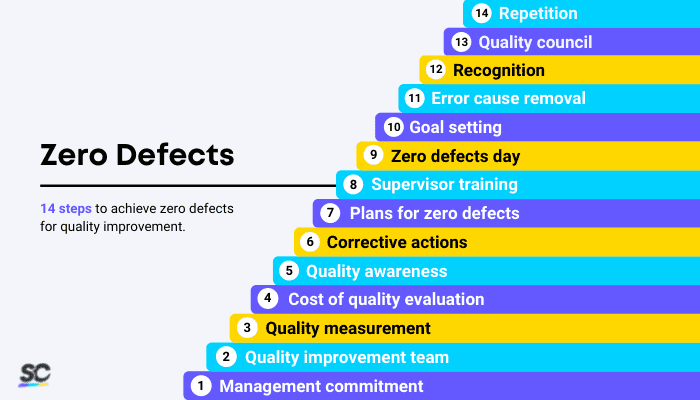What is Zero Defects?
Zero defects is a philosophy founded on the idea of getting things right on the first try. Designed to work for all industries, this all-encompassing philosophy aims to improve efficiency and increase profit for businesses by eliminating the cost of their mistakes. It can lead to better customer satisfaction, a change in perspective, and a continuously improving work environment.
History
The idea of zero defects started with Philip Crosby, a well-known American quality professional. He perpetuated the idea that quality should be invested in the most, as “quality is free.” He believed that investing in quality meant that one should do things right on the first try to assure themselves of a high-quality outcome immediately.
Crosby didn’t give hard rules for achieving one’s standard of quality, declaring quality is neither tangible nor intangible. Quality, he said, was simply about conforming to an organization’s standards and requirements to the best it can be. To achieve this, he placed heavy emphasis on preventing waste when performing essential tasks. Waste here was defined as anything unproductive or inessential to a task, such as certain processes and tools. Prevention was better than cure, and by doing things right the first time and avoiding mistakes, a high standard of quality can be achieved.
Zero defects theory should not be confused with perfectionism, however. The philosophy of zero defects doesn’t mean that people never make mistakes. Instead, it means that companies shouldn’t be working with the idea that not giving one’s best is the norm. Substandard and unclear targets where the final product can just be fixed later should not be expected; instead, management should work to create things right on the first try with clear targets to produce their ideal outcomes.
Today, zero defects is the leading philosophy behind many total quality management and assurance programs across different fields. Together with the Six Sigma concepts and the 5W1H method, it promotes continuous improvement throughout the workplace, ensuring that the standard of quality increases with time, as well as the standard of leadership.
How to Achieve Zero Defects

14 Steps to Zero Defects
Although Crosby did not give clear definitions for quality, he laid out 14 steps to achieving zero defects for quality improvement that can be used by anyone. These are:
- Management commitment: The desire for change should start with leadership. Management must be the first ones to commit to zero defects before cascading it down to the others.
- Quality improvement team: Once management has committed to the task, they should form a team dedicated to total quality improvement and management.
- Quality measurement: The quality improvement team and upper management should convene to define and measure quality. This can be done by identifying the target goals to achieve, what can be done to attain them, and what else can be improved upon.
- Cost of quality evaluation: Identify and understand the cost of the goal you want to achieve. The team should discuss how this affects their organization’s other goals, and see if this standard of quality is something attainable given their other tasks.
- Quality awareness: The definition and measures of quality should be known by everyone in the organization and not just the quality improvement team. Everyone should be aware of what quality means for the organization and gain an understanding of it so they can also work towards it.
- Corrective actions: Now that costs and issues of quality control have been discussed, the members of the organization must work together to create corrective measures to improve internal processes.
- Plans for zero defects: After all discussions and corrective actions, it’s time to establish plans for attaining zero defects. Eliminate all defects and start focusing on what is considered essential.
- Supervisor training: Supervisors should be trained to implement the plans for zero defects across the organization. They should understand what the philosophy of zero defects is and should be able to explain it to the other staff members as well as carry it out themselves.
- Zero defects day: Holding a “zero defects day” is one way to ensure everyone in the organization is aware of the plans and philosophies in place to eliminate defects. On this day, managers and supervisors come together to discuss the plans for zero defects, ensuring everyone is on the same page.
- Goal setting: Management should set goals related to zero defects not only for the organization but also for the teams under it and the employees within them as well.
- Error cause removal: Supervisors and managers should ask their staff for any other issues they encounter that cause them to make mistakes. It’s not uncommon that errors or hindrances to achieving zero defects that are only noticed while working or after initial planning. Discussing them as a group is a good way to identify them and find solutions that can also be adopted by other staff or teams later on.
- Recognition: It’s essential to give proper recognition to those who follow zero defects plans well. Celebrating their success not only encourages them to keep it up, but also motivates others to do the same.
- Quality council: After implementing zero defects plans, managers should convene a quality council to analyze their efforts and the results. The quality council should be composed of quality professionals and internal team leaders, and they should meet regularly to better observe the organization and see if the defined standard of quality is being met along with the company goals.
- Repetition: Ensuring quality is maintained and controlled is not a one-time thing. The philosophy of zero defects is easy to understand, but it will not take effect immediately. It will require trial and error and many discussions, and will constantly require changes as work processes and needs are always changing. Thus, established plans for zero defects should be analyzed regularly to see if they are still relevant and if there are any new issues or errors to address.
Digitize the way you Work
Empower your team with SafetyCulture to perform checks, train staff, report issues, and automate tasks with our digital platform.
Get Started for FreeUsing SafetyCulture (formerly iAuditor) for Zero Defects
It can be hard to keep up with your zero defects plans, especially if you are busy with other matters. To solve this dilemma, you can use a digital checklist. Having a digital checklist can help you track the tasks done in your organization and the errors that your staff encountered, which, in turn, can help you and your quality improvement team improve your zero defects plans accordingly.
SafetyCulture offers a free zero defects implementation plan template for anyone to use and modify as needed. SafetyCulture is a digital inspection app used across different industries to ensure that the quality of their processes and products are controlled through checklists. SafetyCulture can also help you do the following:
- Monitor the achievement of goals and the quality of work done
- Schedule quality inspections
- Report issues through the app via Heads Up, Issues, or Inspections
You can get started with SafetyCulture for free here.




